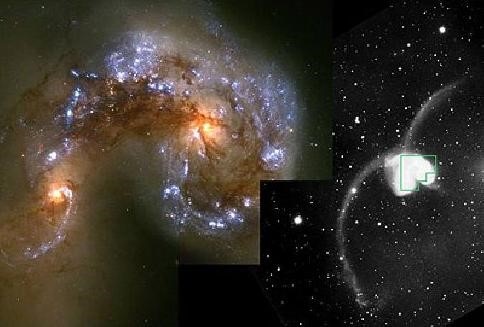Jul 18 2019
In 1785, William Herschel observed a clear night sky using his own telescope as usual. However, that night, he discovered a very strange celestial object in Corvus—the Antennae Galaxy. From that time, celestial objects such as those, known as the merging galaxies, have astonished innumerable astronomers.
 Antennae galaxy. This merging galaxy was first discovered by William Herschel. (Image credit: Hubble Space Telescope, NASA)
Antennae galaxy. This merging galaxy was first discovered by William Herschel. (Image credit: Hubble Space Telescope, NASA)
Currently, questions such as “How is a merging galaxy formed?” and “By what way it evolves?” are hot topics in astronomy.
Almost over two centuries later, currently, researchers have been able to replicate the process of formation of the merging galaxies using numerical simulations. Due to the gravitational attraction, two galaxies would initially come close to each other, observed as a galaxy pair in this stage. Later, the violent collision process results in drastic variations in the galaxies’ shapes, thereby forming unique structures that are considerably different from normal galaxies.
A team of researchers from Shanghai Astronomical Observatory of the Chinese Academy of Sciences (SHAO) recently reported the result of a new study on galaxy pairs. As part of the study, at first, the largest galaxy pair sample to date was built. Then, the bivariate luminosity function of galaxy pairs was accurately measured.
The bivariate luminosity function tells us a whole story on what is the probability of a galaxy that could be paired with another galaxy at given luminosities, and also gives us hints on how often galaxy merging event occurs in the nearby universe.
Prof. SHEN Shiyin, Study Corresponding Author, Shanghai Astronomical Observatory, Chinese Academy of Sciences
The numerical simulation demonstrates that the merging timescale of two galaxies is nearly 1–2 Giga years. Hence, it was not possible for humans to observe the complete process of galaxy merging event. The researchers have used the bivariate luminosity function of galaxy pairs as a statistical technique to probably find the first observational evidence on the galaxy merging timescale.
The global timescale from two gravitational bounded galaxies to final merging depends on the mass configuration of two galaxies. Typically, two massive galaxies with equal mass merge most quickly.
FENG Shuai, Shanghai Astronomical Observatory, Chinese Academy of Sciences
FENG, the first author of the study, is a PhD student supervised by Prof. SHEN.
In this study, apart from the public astronomical database, the Guoshoujing Telescope (also known as LAMOST), located in Xinglong Station of National Astronomical Observatory of Chinese Academy of Sciences (NAOC), has made a considerable contribution.
Fiber collisions typically restrict the number of galaxies in two extremely close galaxies on the sky, like a galaxy pair, that can be targeted by a regular multi-fiber spectroscopic survey (such as Sloan Digital Sky Survey, also called SDSS) to just one.
One of the significant observational samples of the LAMOST spectral survey is to complement the missed main sample galaxies in the SDSS. The combination of the two surveys forms the largest spectroscopic identified galaxy pair sample thus far, thereby offering the basis for this novel statistical study.